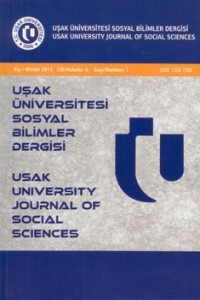Öz
Word formation in Turkish is conducted through roots and suffixes. Added to the noun and verb roots, suffixes give them typical and functional meanings. The suffixes and structures that help nouns relate to other words in the sentence and gain meaning and relate nouns to nouns, verbs and prepositions are evaluated in “case” concept. The suffix that makes nouns instruments is called instrumental case. This suffix, by relating it to verb, helps noun express instrument and time. Commitative case gives noun to which it is added the meaning of co-occurrence. In modern Turkic dialects, both cases are made with the same suffix or word. With structures "birlen, bile, ile, menen" both cases are made. Yakut Turkish is similar to Old Turkish in the cases. The commitative case and the instrumental case are made with two different structures. For the commitative case the suffix +LIIn is used in Yakut Turkish. This suffix gives the meaning of co-occurrence As to Yakut Turkish in terms of instrumental case, we see "+n", the old instrumental suffix, in adverbs and times. The Yakut Turkish version of this suffix is +(I)nAn and it gives the meaning of instrument to the word it is added. The commitative and instrumental suffix in Yakut Turkish exists as one same suffix.
Anahtar Kelimeler
Kaynakça
- Banguoğlu T. (1995) Türkçenin Grameri, Ankara: TDK Yayınları.
- Camrie B. (1981) The Languages of The Soviet Union, Cambridge: Cambridge Language Surveys.
- Gabain A. V.(1995) Eski Türkçenin Grameri, Ankara: TDK Yayınları.
- Gülsevin G. (2007) Eski Anadolu Türkçesinde Ekler, Ankara: TDK Yayınları. İpek B. (ET.30.11.2012) Türk Dilinde Vasıta Hali, www.turkiyat.selcuk. edu.tr/pdfdergi/s23/ipek.pdf.
- Kirişçioğlu M. F. (2007). Saha Türkçesi, Türk Lehçeleri Grameri (Editör: A. Bican Ercilasun), Ankara: Akçağ Yayınları.
- Kirişçioğlu M. F. (2002), Sahalar (Yakutlar) ve Saha Türkçesi, Türkler Ansiklopedisi, C.20, Ankara: Yeni Türkiye Yayınları. s: 133–140
- Kirişçioğlu M. F. (1999), Saha (Yakut) Türkçesi Grameri, Ankara: TDK Yayınları.
- Korkmaz Z. (2009) Türkiye Türkçesi Grameri Şekil Bilgisi, Ankara: TDK Yayınları.
- Kruger J. (1962) Yakut Manual, Bloomıngton: Indıana Unıversity Publıcations, Uralıc Altaıc Series vol.21.
- Pakendorf B. (2007) Contact in Prehistory of The Sakha (Yakuts): Linguistic and Genetic Perspectives, Utrect: LOT Dissertation Series 170.
- Seroşevski V.L. (2007). Saka Yakutlar, İstanbul: Selenge Yayıncılık.
- Somuncuoğlu A. (2002) Saha Cumhuriyeti, Türkler Ansiklopedisi C.20, Ankara: Yeni Türkiye Yayınları. s: 119–131.
- Stachowskı M. (1995) Der Komitativ im Jakutischen und Dolganischen, Analecta Indoeuropaea Cracoviensia vol.II, Krokow: Cracow Universitas. s: 553-559.
- Ubryatova E.İ. (1995) Grammatika Sovremennogo Yakutskogo Literaturnogo Yazıka, Novosibirsk: Sibirskaya İzdatelskaya Firma ran, Nauka.
- Şirin User H. (2006) Başlangıçtan Günümüze Türk Yazı Sistemleri, Ankara: Akçağ Yayınları.
- Yıldız H. (2007) Orhon Türkçesi ile Yakutçanın Sözvarlığı ve Sözyapımı Bakımından Karşılaştırılması, Anadolu Üniversitesi Sosyal Bilimler Enstitüsü, Yayımlanmamış Yüksek Lisans Tezi, Eskişehir.
Öz
Türk dilinde kelime oluşumu kök ve ekler ile sağlanır. Ekler isim ve fiil köklerine eklenerek onlara tür ve görev anlamı kazandırmaktadır. Türkçede isimlerin, diğer kelimelerle ilişki kurarak cümlede görev kazanmasını sağlayan; isimleri isimlere, fiillere ve edatlara bağlayan ek ve yapılar “hâl” kavramı içinde değerlendirilmektedir. İsimleri vasıta haline getiren eke vasıta hali denir. Bu ek ismin instrumental şeklini yapar, ismi fiile bağlayarak vasıta ve zaman ifade etmesini sağlar. Ortaklık hali ise, eklendiği isme birliktelik anlamı katmaktadır. Çağdaş Türk lehçelerinde ortaklık ve vasıta hali aynı ek ya da kelime ile sağlanmaktadır. Bu iki hâl Çağdaş Türk lehçelerinde "birlen, bile, ile, menen" gibi yapılarla sağlanmakta, hem vasıta hem de ortaklık hâli bu şekilde oluşturulmaktadır. Yakut Türkçesi hâl kavramında farklılık göstermektedir. Ortaklık ve vasıta hali iki farklı yapı ile sağlanmaktadır. Ortaklık hâli için Yakut Türkçesinde +LIIn eki kullanılmaktadır. Bu ek kelimeye birliktelik anlamı verir. Yakut Türkçesinde vasıta hâline baktığımızda eski vasıta hâli eki "+n" ekini zarflarda ve zaman isimlerinde görmekteyiz. Bu ekin Yakut Türkçesindeki kullanım şekli +(I)nAn şeklindedir ve eklendiği kelimeye araç ilgisi katmaktadır. Yakut Türkçesinde vasıta ve ortaklık ekleri iki ayrı yapı olarak bulunur.
Anahtar Kelimeler
Kaynakça
- Banguoğlu T. (1995) Türkçenin Grameri, Ankara: TDK Yayınları.
- Camrie B. (1981) The Languages of The Soviet Union, Cambridge: Cambridge Language Surveys.
- Gabain A. V.(1995) Eski Türkçenin Grameri, Ankara: TDK Yayınları.
- Gülsevin G. (2007) Eski Anadolu Türkçesinde Ekler, Ankara: TDK Yayınları. İpek B. (ET.30.11.2012) Türk Dilinde Vasıta Hali, www.turkiyat.selcuk. edu.tr/pdfdergi/s23/ipek.pdf.
- Kirişçioğlu M. F. (2007). Saha Türkçesi, Türk Lehçeleri Grameri (Editör: A. Bican Ercilasun), Ankara: Akçağ Yayınları.
- Kirişçioğlu M. F. (2002), Sahalar (Yakutlar) ve Saha Türkçesi, Türkler Ansiklopedisi, C.20, Ankara: Yeni Türkiye Yayınları. s: 133–140
- Kirişçioğlu M. F. (1999), Saha (Yakut) Türkçesi Grameri, Ankara: TDK Yayınları.
- Korkmaz Z. (2009) Türkiye Türkçesi Grameri Şekil Bilgisi, Ankara: TDK Yayınları.
- Kruger J. (1962) Yakut Manual, Bloomıngton: Indıana Unıversity Publıcations, Uralıc Altaıc Series vol.21.
- Pakendorf B. (2007) Contact in Prehistory of The Sakha (Yakuts): Linguistic and Genetic Perspectives, Utrect: LOT Dissertation Series 170.
- Seroşevski V.L. (2007). Saka Yakutlar, İstanbul: Selenge Yayıncılık.
- Somuncuoğlu A. (2002) Saha Cumhuriyeti, Türkler Ansiklopedisi C.20, Ankara: Yeni Türkiye Yayınları. s: 119–131.
- Stachowskı M. (1995) Der Komitativ im Jakutischen und Dolganischen, Analecta Indoeuropaea Cracoviensia vol.II, Krokow: Cracow Universitas. s: 553-559.
- Ubryatova E.İ. (1995) Grammatika Sovremennogo Yakutskogo Literaturnogo Yazıka, Novosibirsk: Sibirskaya İzdatelskaya Firma ran, Nauka.
- Şirin User H. (2006) Başlangıçtan Günümüze Türk Yazı Sistemleri, Ankara: Akçağ Yayınları.
- Yıldız H. (2007) Orhon Türkçesi ile Yakutçanın Sözvarlığı ve Sözyapımı Bakımından Karşılaştırılması, Anadolu Üniversitesi Sosyal Bilimler Enstitüsü, Yayımlanmamış Yüksek Lisans Tezi, Eskişehir.
Ayrıntılar
| Birincil Dil | Türkçe |
|---|---|
| Bölüm | Makaleler |
| Yazarlar | |
| Yayımlanma Tarihi | 1 Haziran 2014 |
| Yayımlandığı Sayı | Yıl 2014 Cilt: 7 Sayı: 1 |
Adres: Uşak Üniversitesi Sosyal Bilimler Enstitüsü
Telefon: 0276 221 21 60 Faks :0276 221 21 61
E-posta: sosyaldergi@usak.edu.tr


